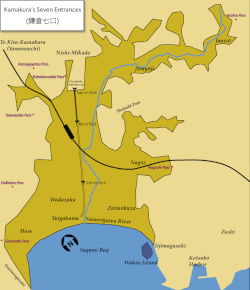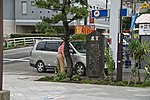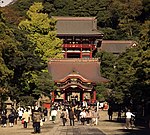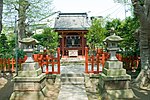Kamakura shogunate
The Kamakura shogunate (Japanese: 鎌倉幕府, Hepburn: Kamakura bakufu) was the feudal military government of Japan during the Kamakura period from 1185 to 1333.The Kamakura shogunate was established by Minamoto no Yoritomo after victory in the Genpei War and appointing himself as shōgun. Yoritomo governed Japan as military dictator from the eastern city of Kamakura with the emperor of Japan and his Imperial Court in the official capital city of Heian-kyō (Kyoto) as figureheads. The Kamakura shōguns were members of the Minamoto clan until 1226, the Fujiwara clan until 1252, and the last six were minor princes of the imperial family. The Hōjō clan were the de facto rulers of Japan as shikken (regent) of the shōgun from 1203. The Kamakura shogunate saw the Jōkyū War in 1221 and the Mongol invasions of Japan under Kublai Khan in 1274 and 1281. The Kamakura shogunate was overthrown in the Kenmu Restoration under Emperor Go-Daigo in 1333, re-establishing Imperial rule until Ashikaga Takauji and his offspring overthrew the imperial government and founded the Ashikaga shogunate in 1336 (Nanboku-chō period).
Excerpt from the Wikipedia article Kamakura shogunate (License: CC BY-SA 3.0, Authors).Kamakura shogunate
Kamakura
Geographical coordinates (GPS) Address Nearby Places Show on map
Geographical coordinates (GPS)
| Latitude | Longitude |
|---|---|
| N 35.316666666667 ° | E 139.55 ° |
Address
248-0012 Kamakura
Japan
Open on Google Maps









